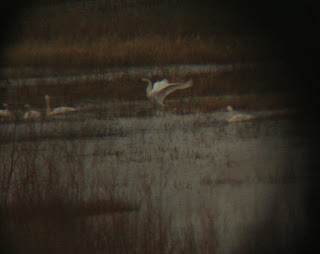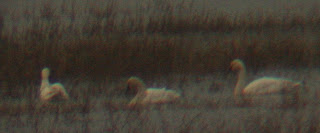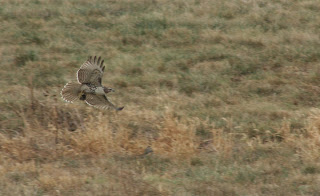The swans were still swimming today, thankfully, so an accurate identification was made. Access to the Melco flood basin site adjacent to the landfill is restricted access but they do give birders permission to set up their scopes if something exceptional is being seen. So today I joined Pat and Jane Bell and Carol Besse for a brief, cold, and wet look at some beautiful swans. It was determined the mystery swans were Tundra Swans based on the extensive pink on the bill of the juvenile and the yellow spot on the bill which was seen on an adult.
So I was able to snap off a few more pictures, but nothing exceptional. The pictures were taken through my scope and it was raining pretty hard, plus I had to crop them way down, so they may resemble the Loch Ness Monster more than a Tundra Swan.



The dusky looking bird above on the left is the juvenile. It's tough but if you look closely you can see the bill is mostly a pinkish orange color, with black at the tip, as opposed to the juvenile Trumpeter Swan, which has black at the base of the bill as well. Nevertheless, we proceeded to get closer to be 100% sure we were correct. When we got closer the birds started to swim away, guess we were getting a little too close, but luckily Carol was able to spot the yellow spot on the bill, confirming the hunch that it was a Tundra Swan. I wasn't able to capture that in the pictures unfortunately, but you can see how some of the birds have a rusty tinge to their heads and necks, which I recently learned they acquire from foraging in ferrous wetland soils.
On another note, I will be participating in World Bird Wednesday, a meme created by Springman at the Pine River Review to bring together nature bloggers from around the world to share out sightings. Check it out!
So I was able to snap off a few more pictures, but nothing exceptional. The pictures were taken through my scope and it was raining pretty hard, plus I had to crop them way down, so they may resemble the Loch Ness Monster more than a Tundra Swan.



The dusky looking bird above on the left is the juvenile. It's tough but if you look closely you can see the bill is mostly a pinkish orange color, with black at the tip, as opposed to the juvenile Trumpeter Swan, which has black at the base of the bill as well. Nevertheless, we proceeded to get closer to be 100% sure we were correct. When we got closer the birds started to swim away, guess we were getting a little too close, but luckily Carol was able to spot the yellow spot on the bill, confirming the hunch that it was a Tundra Swan. I wasn't able to capture that in the pictures unfortunately, but you can see how some of the birds have a rusty tinge to their heads and necks, which I recently learned they acquire from foraging in ferrous wetland soils.
On another note, I will be participating in World Bird Wednesday, a meme created by Springman at the Pine River Review to bring together nature bloggers from around the world to share out sightings. Check it out!






 5:47 PM
5:47 PM
 Ryan Ankeny
Ryan Ankeny


















